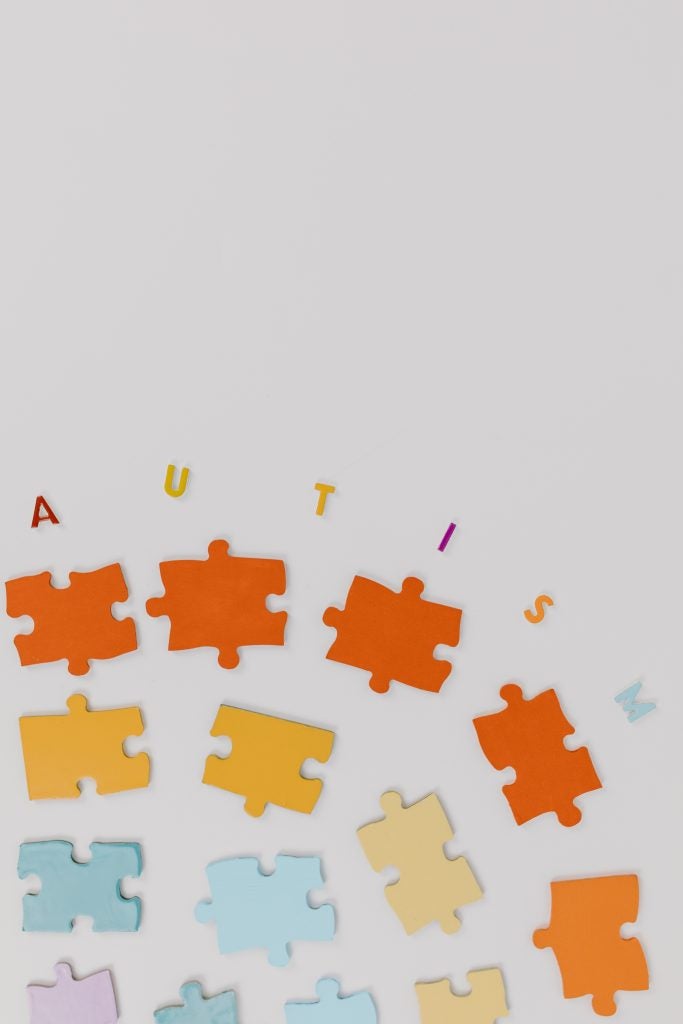
Autism is a “spectrum disorder,” meaning that symptoms can present themselves in a wide variety of combinations, from mild to severe; for this reason autism may also often be referred to as Autism Spectrum Disorder.1 Autism initially manifests in early childhood through a child’s difficulty in communicating or interacting with others.2 Some children may also perform repetitive movements or activities and become upset at changes in daily routine.1 Most parents of children with autism suspect that their child has a cognitive disorder by the age of 18 months and seek professional support by the age of two.1 At 18 months, symptoms of communication impairment in children with autism may vary from moderate to severe and can include: inability to start or maintain conversation, communication with repeated gestures rather than words, avoidance of eye contact, withdrawn nature, lack of empathy, and inability to make friends. Many different theories exist as to the cause of autism, including theories faulting abnormal brain chemistry as well as chromosomal abnormalities.4 Recent research, however, indicates that autism may be caused by a combination of both genetic and environmental factors.3 Autism is believed to be linked to abnormal biology and chemistry in the brain.2 The exact causes of autism are unknown, but irregularities in brain structures such as the corpus callosum (facilitates communication between the two hemispheres of the brain), the amygdala (affects emotion and social behavior), and the cerebellum (involved with motor activity, balance, and coordination) have a significant association with the abnormalities and neurological problems associated with this disease.2 It is believed that these abnormalities occur during pre-natal development and that the imbalances in chemicals called neurotransmitters affect emotion, behavior, and brain activity. These abnormalities may account for autistic behaviors such as difficulties in pretend play, social interactions, and verbal and nonverbal communication. The exact number of children with autism is unknown, but it has been reported that 1 in every 110 children has been identified with an autism spectrum disorder (ASD).1 Although there are no known treatments for autism early intervention, such as behavioral and speech therapy, can help improve a child’s learning skills and increase communication to allow them to communicate more effectively and confidently throughout their life.1
Sexuality and Autism
Despite social and communication difficulties, by the onset of puberty individuals with autism may seek a romantic relationship and/or sexual activity. Like non-affected adults, individuals with autism spectrum disorders show the entire range of sexual behaviors and may seek romantic relationships just as non-affected individuals do. However, due to the core symptoms of the disorder spectrum, including the deficits in social skills, sensory hypo- and hypersensitivities, and repetitive behaviors, some autism Spectrum Disorder (ASD) individuals might develop quantitatively above-average or non-normative sexual behaviors and interests.6 Individuals with developmental disabilities such as autism may face difficulties when expressing their sexuality, and they may have more difficulty than other teens in initiating appropriate contact.5 Such barriers include social myths, insufficient knowledge and training opportunities, personal discomfort, and limited access to available and appropriate educational resources.5 These barriers to expressing sexuality may result in a lack of guidance, opportunity, emotional support, education, or acknowledgement of sexuality by caregivers.5 Informal education about sexuality occurs constantly through interactions with, and observations of, others and through the media.5 Young people with Autistic Spectrum Disorder (ASD) may have already formed unhealthy opinions and views about sexuality, which can affect their self-esteem and interactions with others. Also, young adults with autism may become sexually active with others at an age later than their peers and may take longer to find a partner.5 Obvious signs of longing to engage sexually active arise when people with autism start noticing the bodies and physical features of others and when they begin engaging in masturbation. Oftentimes, this newly found sex drive might lead to inappropriate sexual behavior (i.e. masturbating in public), resulting from a lack of knowledge about privacy and social behavioral norms.

People with ASD sometimes lack the maturity and social skills to interact responsibly with a partner. Many desire long-term relationships, intimacy, and sexual contact just as non-affected individuals do, but individuals with autism are often rejected. This can have a large negative affect on the individual’s self-esteem and wellbeing. Meanwhile, those who are in long-term relationships with an autistic partner often report either infrequent sexual activity due to communication or physical difficulties, or an overactive sex drive due to heighted sensory feelings during stimulation. Because of these circumstances, individuals with autism are commonly dissuaded from sexual activity or are misinformed about sexual education.5 People with autism have the right to form relationships and have sexual experiences if they feel comfortable doing so. They also have the right to regulate their own birth control, and to be protected from automatic sterilization. It is important that individuals with autism receive adequate education and resources to be able to undertake this part of life safely, legally, and in an appropriate manner. However, those with more severe mental impairment also have the right to be protected from sexual exploitation if the person lacks the capacity to give informed consent. No one can give consent on behalf of the disabled, thus, if a person is judged by a psychiatrist or parent to be incapable of giving consent, it is the caregiver’s responsibility to protect the person from sexual contact, which could be deemed sexual assault or statutory rape.
It is important that families, schools, and service providers treat the topics of puberty, sexuality, and relationships with the upmost respect and sensitivity, as these attitudes can have a profound lifelong effect on sexuality. Young people with autism must learn that it is okay to be attracted to someone of the same sex, as orientation may be either fascinating or a very obscure concept. Individuals with autism may ask a lot of questions regarding their sexuality, so it is essential that these individuals have the means to acquire information about safe and informed sexual choices. It is important to allow for opportunities to ask questions in a comfortable environment where they can be answered honestly.
The Arc, a national organization of and for intellectually disabled people asserts that these people have a right not only to engage in sexual relationships, but also to marry and have children. If individuals with autism do have children, they also have a right to receive assistance raising them.
Concluding Remarks

Autism Spectrum Disorder (ASD) is a spectrum of developmental disorders that impair an affected individual’s ability to communicate and interact with others.6 Although individuals with autism may face more difficulties communicating or interacting with others, many individual’s with autism are also able to lead happy, healthy, and self-sufficient lives that may involve romantic relationships. Having a relationship with an individual with autism can be as rewarding as any other relationship. However, there may be adjustments that a partner of an individual with autism may need to make, such as thinking about the way that they communicate with their partner in a different way.7 They may have the additional responsibility of helping their partner with autism to manage money, find employment, and/or supporting them to advocate for themselves.7
References
- “Talking to Parents About Autism.” Iowa Department of Education: EducatIowa.gov. April 2010. Date Accessed: 10 April 2019.
- Sparks, B.F. et al. “Brain structural abnormalities in young children with autism spectrum disorder.” American Academy of Neurology. Ed. 59. AAN Enterprises, Inc.: 29 November 2007. p. 184. Date Accessed: 10 April 2019.
- Deth, Richard et. al. “How environmental and genetic factors combine to cause autism: A redox/methylation hypothesis.” Elsevier. January 2007. p. 190. Date Accessed: 10 April 2019.
- “A Genomewide Screen for Autism: Strong Evidence for Linkage to Chromosomes 2q, 7q, and 16p.” Elsevier. Vo. 69, No. III. Elsevier Inc.: 30 April 2007. p. 570. Date Accessed: 10 April 2019.
- Koller, Rebecca. “Sexuality and Adolescents with Autism.” Sexuality and Disability. Vol. 18. No. 2. Human Sciences Press Inc.: 2000. p. 125. Date Accessed: 10 April 2019.
- Schöttle, Daniel et.al. “Sexuality in autism: hypersexual and paraphillic behavior in women and men with high-functioning autism spectrum disorder.” Dialogues in Clinical Neuroscience. Vol. 19. No. 4. p. 381. Date Accessed: 10 April 2019.
- “Partners of Autistic People.” National Autistic Society. 25 January 2018. Date Accessed: 10 April 2019.
Last updated: 6 May 2019.
